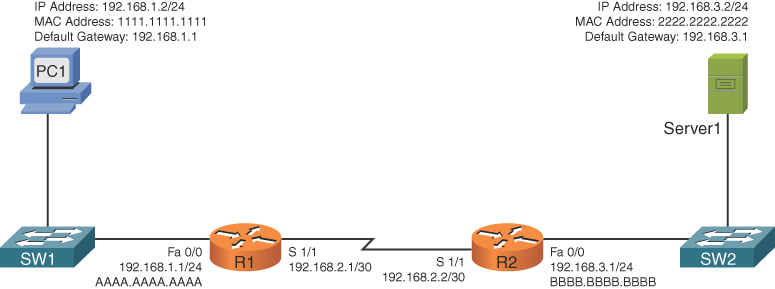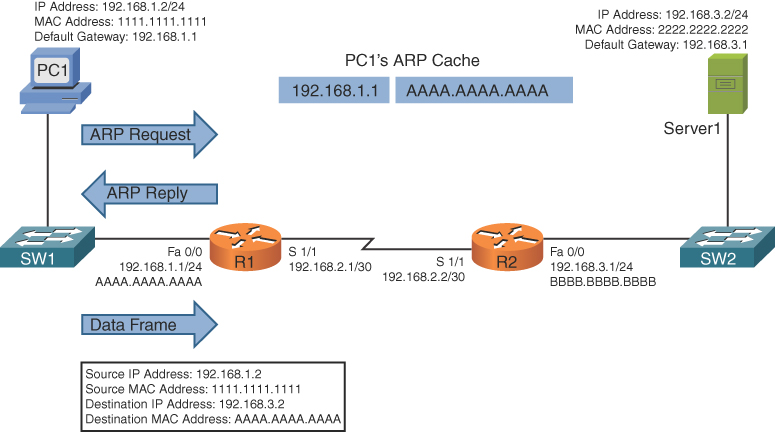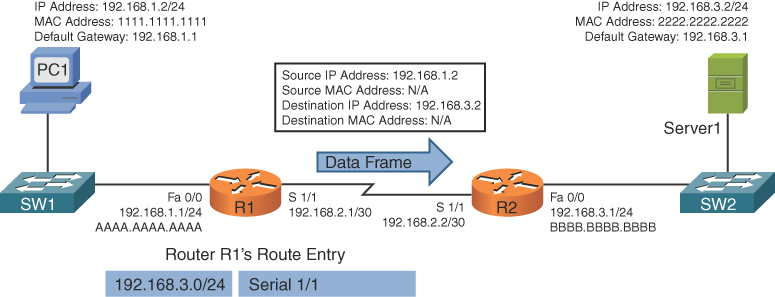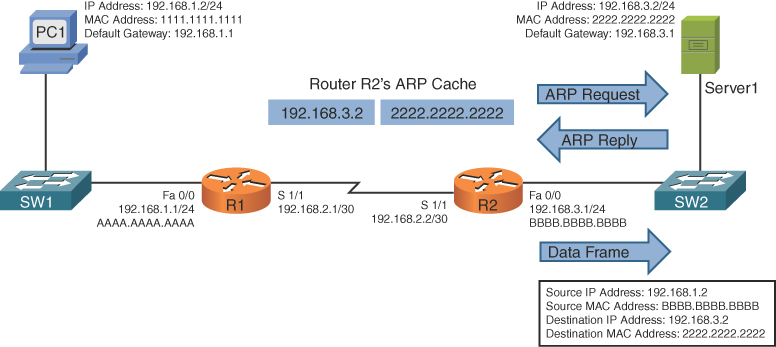Routing
To understand basic routing processes, consider Figure 10-1. In this topology, PC1 needs to send traffic to Server1. Notice that these devices are on different networks. In this topology, how does a packet from the source IP address 192.168.1.2 get routed to the destination IP address 192.168.3.2?

FIGURE 10-1 Basic Routing Topology
It might help to walk through this process systematically:
Step 1. PC1 compares its IP address and subnet mask 192.168.1.2/24 with the destination IP address and subnet mask 192.168.3.2/24. PC1 concludes that the destination IP address resides on a remote subnet. Therefore, PC1 needs to send the packet to its default gateway, which could have been manually configured on PC1 or dynamically learned via Dynamic Host Configuration Protocol (DHCP). In this example, PC1 has the default gateway 192.168.1.1 (router R1). However, to construct a Layer 2 frame, PC1 also needs the MAC address of its default gateway. PC1 sends an Address Resolution Protocol (ARP) request for router R1’s MAC address. After PC1 receives an ARP reply from router R1, PC1 adds router R1’s MAC address to its ARP cache. PC1 now sends its data in a frame destined for Server1, as shown in Figure 10-2.

FIGURE 10-2 Basic Routing: Step 1
Step 2. Router R1 receives the frame sent from PC1 and interrogates the IP header. An IP header contains a Time-to-Live (TTL) field, which is decremented once for each router hop. Therefore, router R1 decrements the packet’s TTL field. If the value in the TTL field is reduced to 0, the router discards the frame and sends a “time exceeded” Internet Control Message Protocol (ICMP) message back to the source. As long as the TTL has not been decremented to 0, router R1 checks its routing table to determine the best path to reach network 192.168.3.0/24. In this example, router R1’s routing table has an entry stating that network 192.168.3.0/24 is accessible via interface Serial 1/1. Note that ARP is not required for serial interfaces because these interface types do not have MAC addresses. Router R1, therefore, forwards the frame out its Serial 1/1 interface, as shown in Figure 10-3.

FIGURE 10-3 Basic Routing: Step 2
Step 3. When router R2 receives the frame, it decrements the TTL in the IP header, just as router R1 did. Again, as long as the TTL has not been decremented to 0, router R2 interrogates the IP header to determine the destination network. In this case, the destination network 192.168.3.0/24 is directly attached to router R2’s Fast Ethernet 0/0 interface. Similar to the way PC1 sent out an ARP request to determine the MAC address of its default gateway, router R2 sends an ARP request to determine the MAC address of Server1. After an ARP reply is received from Server1, router R2 forwards the frame out its Fast Ethernet 0/0 interface to Server1, as illustrated in Figure 10-4.

FIGURE 10-4 Basic Routing: Step 3
The previous steps identified two router data structures:
IP routing table: When a router needed to route an IP packet, it consulted its IP routing table to find the best match. The best match is the route that has the longest prefix. Specifically, a route entry with the longest prefix is the most specific network. For example, imagine that a router has an entry for network 10.0.0.0/8 and for network 10.1.1.0/24. Also, imagine that the router is seeking the best match for destination address 10.1.1.1/24. The router would select the 10.1.1.0/24 route entry as the best entry because that route entry has the longest prefix (/24 is longer than /8, which is a more specific entry).
Layer 3 to Layer 2 mapping: In the previous example, router R2’s ARP cache contained Layer 3 to Layer 2 mapping information. Specifically, the ARP cache had a mapping that said MAC address 2222.2222.2222 corresponded to IP address 192.168.3.2.
As shown in the preceding example, routers rely on their internal routing table to make packet-forwarding decisions. So how does a router’s routing table become populated with entries? That is the focus of the next section.
